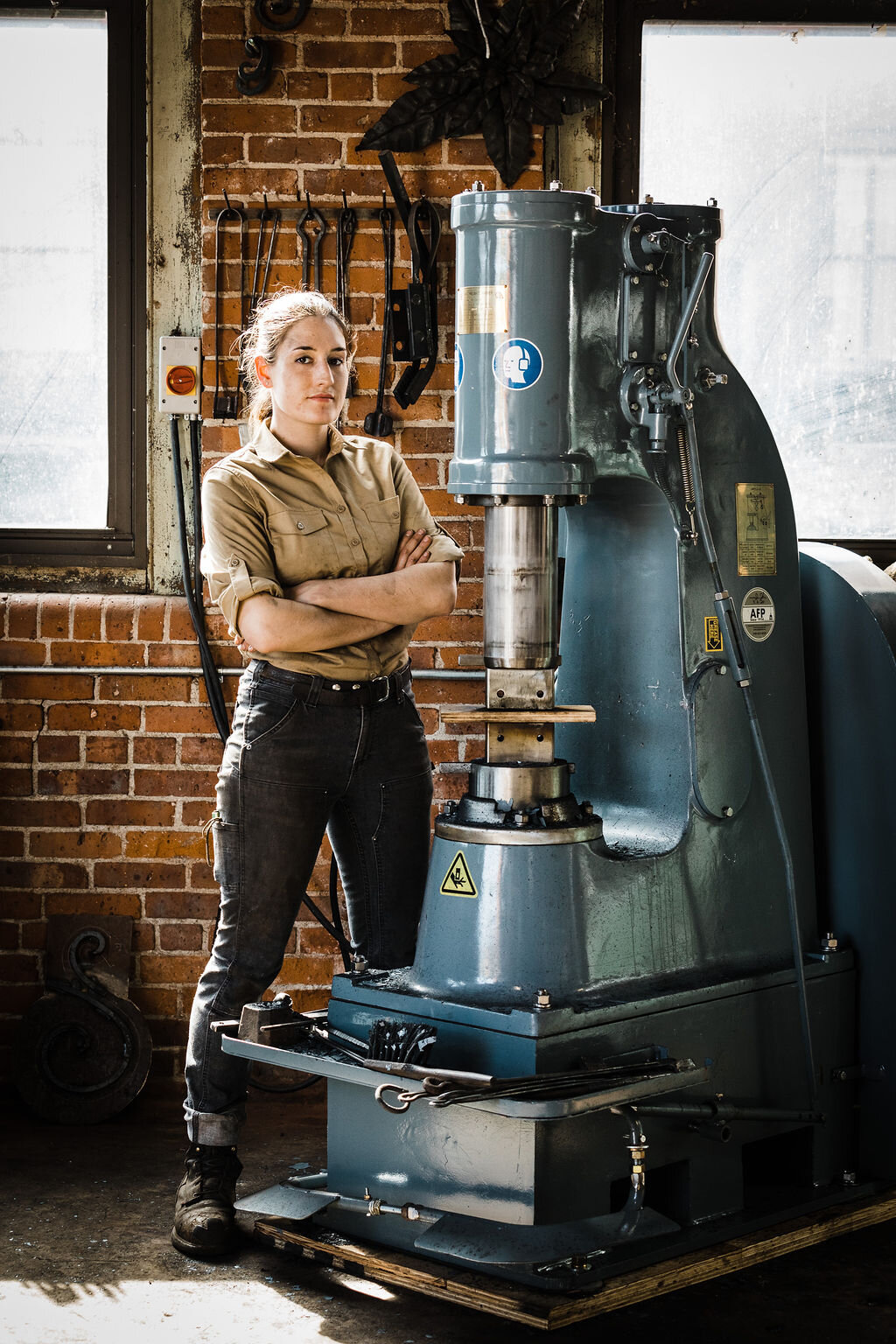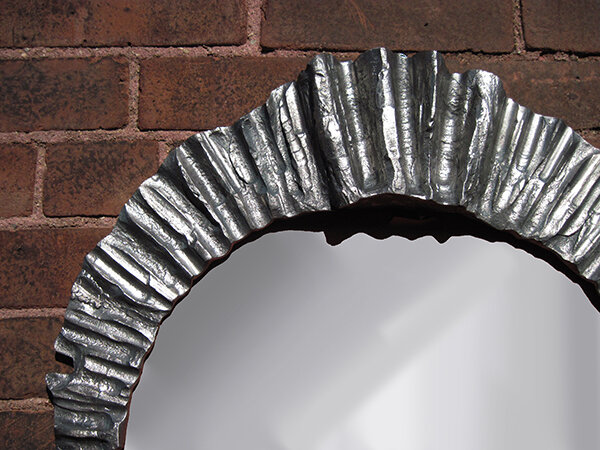2020 PVD Design Catalyst: Alaina Mahoney of A.M. Design and Fabrication
July 22, 2020 /// Featuring: Alaina Mahoney of A.M. Design and Fabrication
ALAINA MAHONEY of A.M. DESIGN AND FABRICATION LLC
Photo by Rue Sakayama Photography.
1. Tell us about your company!
A.M. Design and Fabrication LLC is a Providence-based ornamental metal shop that specializes in restoration, new custom work, and functional sculpture.
2. How has the Catalyst program impacted your business? What aspects of the program did you find most valuable?
The Design Catalyst program has, over the 5 months, completely changed my perspective on what my business can achieve. With funding provided by the Catalyst program, I was able to transform A.M. Design’s blacksmithing area by purchasing a new, self-contained air hammer that has greatly expanded the capabilities of the shop. Using this hammer, we are creating a product line that showcases our sculptural abilities which will be released in 2021.
In workshops and clinics, I learned about marketing and the importance of promoting myself so that my customers know and trust who they’ll be dealing with before they make contact. We are now armed with a plethora of marketing, communication, and planning tools to take A.M. Design to the next level.
With the help from my mentor, Layne Mayer, I have been able to rethink the way I pursue custom work, and I am better equipped to choose my customers based on how we can best work together and how my specific skills meet their needs. She was also a constant force encouraging me to keep going. Additionally, I had some extremely transformative discussions with workshop leaders. Armed with this new toolbox, I plan to move forward with A.M. Design pursuing connections with the type of clients that will achieve the most impactful results for our design growth.
I can’t wait to look back next January and see how far A.M. Design has come, despite the difficulties of the pandemic.
3. Why did you start your business?
I started this business as a means to an end. I graduated from Massachusetts College of Art and Design in 2010 with a degree in painting, and I had every intention to find my way as a professional artist. I took a job at a metal fabrication company so that I could learn how to make gates for my paintings as part of an art series. Flash forward 10 years--while I still paint, I am discovering more and more ways to be an artist within the realm of A.M. Design. This pursuit of creativity is the idea behind my decision to release a product line. I want each release to represent a series where I explore a type of form or mark-making that interests me. I will use the techniques I learn while producing these series to reflect back into my art work, and vice versa. My hope is that my artistic pursuits become an important and integral part of A.M. Design and Fabrication’s revenue stream.
4. What advice would you give to your younger self?
Don’t take every job. At many points throughout these past five years, I have said “yes” to lower-paying work out of fear for the future. In custom metalwork in New England, the looming winter is always a fear-factor because most customers don’t think about a new railing, gate, etc. What happens, time and time again is that the lower-paying jobs get in your way. You have less energy to put into better jobs when they come, and that’s how you burn out. This program has helped me to value my skills and stick to my shop rate when bidding jobs.
Photo by Rue Sakayama Photography.
5. What do you still dream to achieve? What are your goals for the upcoming year?
A.M. Design will release a line of products in 2021 that celebrates a type of radiating, explosive, severe mark-making, and texture that I have been working with under our new power hammer. This line will be a cohesive series of functional sculptures for the home. I plan to continue to release future lines this way, focusing on a particular style of sculpture that I want to explore using items such as mirrors, napkin rings, curtain holders, and shelf brackets as my canvases.
Photo by Alaina Mahoney.
6. Finish this sentence! When I’m not designing I’m…
Growing a jungle out of the tiny dirt patch behind my house, spending time with my partner, or petting an exceptionally fluffy kitten who lives with us. I used to take time for martial arts and I hope that with my new time-management skills acquired through the cohort, I can return when gyms are open again.
7. When are you most creative?
I am the most creative when clients allow me full control over the design process–when they have faith in my abilities and want something that reflects my style and sensibilities.
8. What do you love about working in Rhode Island?
My favorite part about working in Rhode Island is the celebratory and supportive environment. Creative individuals are treasured here and considered a great economic and social asset to the state! Programs like the Design Catalyst program, which is partially funded by the state of Rhode Island, are examples of this desire to support and keep design-driven businesses here, working and succeeding.
9. Why do you have your business in Providence? What draws you to the City?
I was drawn to Providence initially because of its reputation for supporting the arts. Its sales tax exemption for art sales was a clear indication that Providence was dedicated to keeping artists happy and working. When I made the decision to move from Boston in 2014, I was happy to find that this was a place where my type of business–that is blacksmithing, casting, and welding–would be welcomed into any one of its abundant heavy-industrial appropriate spaces. I was even more pleased to find a building managed by an artist who supports my vision for my business and the space we occupy. Providence has an extremely supportive art and design community, and the Design Catalyst program led by DESIGNxRI is yet another example of this.
10. How has the current global health pandemic and the social, political, and cultural unrest impacted your business?
I think business owners have a great responsibility to step up as leaders at this time. We have the power to hire others, pay vendors, and lead change. In an effort to buy black and use my economic power for social improvement, I have realized how much of construction-related trade in this area is white-owned. When I list a job opportunity online, almost all responses are from white members of the public. Moving forward, I am committed to learning about racial disparity in the trades and working to combat it.
Photo by Rue Sakayama Photography.





